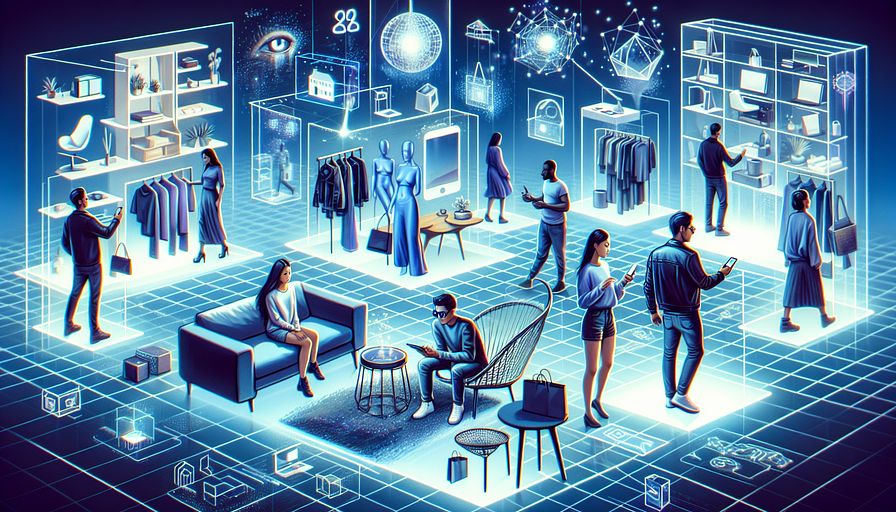Abstract:
Augmented Reality (AR) is transforming the retail sector by enhancing the customer shopping experience and creating more interactive and personalized services. Retailers are leveraging AR to enable customers to visualize products in their own space before making a purchase, effectively bridging the gap between online and physical shopping. Virtual try-on solutions, interactive displays, and detailed product previews are just a few examples of how AR is being used to engage consumers and drive sales. This technology also offers retailers valuable insights into consumer behavior, helping to tailor offerings more closely to customer preferences. As AR technology becomes more accessible and consumers seek more immersive shopping experiences, its adoption in the retail industry is expected to accelerate, paving the way for innovative shopping experiences and the future of retail.
Revolutionizing Retail with Augmented RealityThe retail sector is undergoing a significant transformation, courtesy of Augmented Reality (AR). This technology is not just adding a layer of digital information to our physical world; it's reshaping how consumers shop and interact with products. By offering more interactive and personalized shopping experiences, AR is effectively narrowing the divide between online and physical stores. Imagine being able to visualize a new sofa in your living room or seeing how a pair of glasses looks on your face before hitting the purchase button. That's the kind of convenience and innovation AR brings to the table, making shopping not just a task but an experience to look forward to.
The Magic of Virtual Try-On Solutions
One of the most engaging applications of AR in retail is the virtual try-on solution. This technology allows customers to see themselves wearing glasses, jewelry, or even clothes without physically trying them on. It's like having a personal fitting room in your pocket, minus the hassle of taking your shoes off every time you want to try something new. Virtual try-ons are not only fun but they also save time and reduce the hassle of returns for both customers and retailers. It's a win-win situation where the magic of AR meets the practicality of shopping, transforming the try-before-you-buy concept into a digital reality.
Interactive Displays: A New Way to Engage
Retailers are also utilizing AR to create interactive displays that offer detailed product previews and stories. These displays can transform a mundane shopping trip into an adventure, where products come to life through the screen of a smartphone or tablet. Imagine pointing your device at a wine bottle and seeing the vineyard it came from, the winemaking process, and food pairing suggestions. This level of interaction not only entertains but educates the customer, creating a richer understanding and appreciation for the products they are considering.
Visualizing Products in Personal Spaces
Another groundbreaking feature of AR technology is enabling customers to visualize products in their own spaces. Furniture and home decor retailers are at the forefront of this innovation, offering apps that allow users to see how a new couch or lamp would look in their living room. This eliminates the guesswork and uncertainty associated with online shopping, where dimensions and styles might be hard to gauge. By allowing customers to see exactly how products fit and look in their intended environment, AR is bridging the gap between the convenience of online shopping and the assurance of brick-and-mortar stores.
Insights into Consumer Behavior
Beyond enhancing the customer experience, AR offers retailers a treasure trove of data on consumer behavior. Every interaction with an AR feature can be tracked and analyzed, providing insights into preferences, engagement levels, and even how long a customer considers a product before making a decision. This information is invaluable for retailers looking to tailor their offerings and marketing strategies to meet customer needs more precisely. Essentially, AR can act as a bridge between retailers and consumers, allowing for a deeper understanding of what drives purchase decisions and how to create more targeted, effective shopping experiences.
The Future of Shopping
As AR technology becomes more widespread and consumer appetite for immersive shopping experiences grows, the adoption of AR in the retail sector is set to increase. This isn't just about keeping up with the latest tech trends; it's about redefining the shopping experience. Retailers who embrace AR are paving the way for a future where shopping is not only about acquiring items but about enjoying a rich, personalized, and interactive journey. The potential for AR in retail is vast, from virtual fitting rooms and interactive displays to in-depth product exploration and visualization in personal spaces. This technology is setting the stage for an innovative shopping era, one where the lines between physical and digital commerce blur, creating seamless, engaging, and highly personalized experiences for consumers.
Indeed, the integration of AR into the retail sector signifies more than just a technological advancement; it marks a shift in how businesses connect with their customers and how consumers approach shopping. The future of retail is bright, and it's augmented. So, next time you're about to make a purchase, don't be surprised if AR plays a role in making your decision. After all, shopping is no longer just about buying; it's about experiencing, and AR is leading the charge in creating those experiences. Who knew shopping could get even more exciting?





